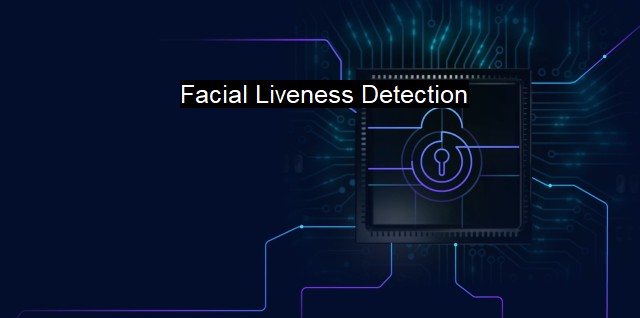What is Facial Liveness Detection?
Facial Liveness Detection: Safeguarding Against Deep Fake Attacks in Face Recognition Technology
Facial Liveness Detection is an emerging technologically advanced procedure that plays indispensable roles in our digitally driven world today. It exists as a robust tool used in combating identity theft, enhancing biometric security, significantly reducing the risks of spoof attacks and achieving better data protection. As Cybersecurity and Antivirus developments advance in tandem, it's growing exponentially important to dissect what lies at the core of Facial Liveness Detection systems.In simple terms, Facial Liveness Detection is a mechanism that discerns between a live, physical face and an artificial one. Artificial faces could take the form of photos, masks, video playback or sophisticated 3D models that cyber attackers often use to trick biometric security systems. Rather than simply matching biometric details, Facial Liveness Detection goes the extra mile to assess the authenticity of facial features, providing an additional layer of protection.
The advent of Facial Liveness Detection revolutionizes the cybersecurity landscape, significantly enhancing identity verification procedures. It challenges the outdated methods in the security space like passwords, keycards, and fobs, ushering the world into an age of reinforced Cybersecurity. For businesses reliant on digital ecosystems, the introduction of this technology brings impressive benefits. It not only offers robust security measures but contributes to user convenience, creating a seamless experience.
There are copious methods employed by Facial Liveness Detection systems to detect any spoof attacks. Some use textured analysis with advanced algorithms for highly accurate scrutiny of facial features in three-dimensional planes. Other technologies like active and passive liveness checks proactively detect for liveness on observed face in real-time. Active liveness detection might ask users to blink, nod, or perform specific movements. On the other hand, passive approaches inspect the spontaneity of eye-blinks or other facial movements that can confirm the presence of a real person.
Facial liveness detection provides critical support to myriad industries. For instance, banking sectors have started employing it to enhance their Know Your Customer (KYC) procedures. As customers log in to their accounts, these systems ensure that only legitimate users gain access, thereby protecting the individuals' sensitive information. Similarly, in e-commerce or any online service platform with user accounts, Facial Liveness Detection aids in preventing account takeovers thus maintaining the sanctity of user trust and data protection. In the context of digital media and entertainment industry, it forestalls piracy and unauthorized usage.
Amidst the Covid-19 pandemic, the further digitization of various sectors poses new threats in the cyber landscape and heightens the significance of Facial Liveness Detection. The implications of these breaches aren’t just limited to financial tolls, but they can also end up compromising the privacy and safety of various individuals.
In the cybersecurity domain, the advent of stronger, smarter malicious software constantly calls for groundbreaking counter-technology. Just like an antivirus program evolves to better detect and neutralize threats, Facial Liveness Detection technologies are also consistently evolving, becoming more advanced, nuanced, and discerning. With the sanguine potential to strengthen digital security for individuals, corporations, and governments alike, the evolution and growth of Facial Liveness Detection is intriguing.
Even so, we ought to bear in mind, as beneficial as these technologies are, the security loopholes they aim to fill can be endless. No security measure is foolproof. That being said, strides such as these in the realm of cybersecurity can only bode well for users worldwide. It clearly underlines the adaptability and resilience of technology in pushing the boundaries of protection against fraudulent activities in the cyberworld. Thus, facial liveness detection emerges as an essential aspect of contemporary cybersecurity amid the continuous rise of digital threats.

Facial Liveness Detection FAQs
What is facial liveness detection?
Facial liveness detection is a technology that verifies the authenticity of a facial image or video by checking for signs of life, such as eye movements or facial expressions. It is often used in cybersecurity and antivirus systems to prevent spoofing attacks.How does facial liveness detection work?
Facial liveness detection works by analyzing a person's facial gestures, movements, and characteristics to determine if the face is real or fake. It may use different methods, such as asking the person to blink or move their head, tracking the alignment of facial features, or analyzing the texture of the skin.What are the benefits of facial liveness detection?
Facial liveness detection can help enhance the security and accuracy of cybersecurity and antivirus systems. It can prevent fraud, identity theft, and unauthorized access to sensitive data or systems. It can also improve user experience by reducing the need for passwords or other authentication methods.Is facial liveness detection foolproof?
No, facial liveness detection is not foolproof, and it may not work in all situations. Some advanced spoofing techniques or tactics, such as 3D masks or deepfakes, may bypass facial liveness detection. Therefore, it is crucial to combine facial liveness detection with other authentication methods or security measures to maximize its effectiveness.| | A | | | B | | | C | | | D | | | E | | | F | | | G | | | H | | | I | | | J | | | K | | | L | | | M | |
| | N | | | O | | | P | | | Q | | | R | | | S | | | T | | | U | | | V | | | W | | | X | | | Y | | | Z | |
| | 1 | | | 2 | | | 3 | | | 4 | | | 7 | | | 8 | | |||||||